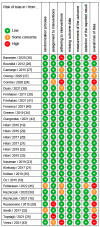Innovative Diagnostic and Therapeutic Interventions in Cervical Dysplasia: A Systematic Review of Controlled Trials
- PMID: 35681649
- PMCID: PMC9179487
- DOI: 10.3390/cancers14112670
Innovative Diagnostic and Therapeutic Interventions in Cervical Dysplasia: A Systematic Review of Controlled Trials
Abstract
Cervical dysplasia is a common precancerous lesion affecting 1% to 2% of women worldwide. Significant progress in the diagnosis and treatment of cervical dysplasia have been made in the last decade. We performed a systematic literature search of the databases PubMed and Cochrane Central Register of Controlled Trials to identify controlled clinical trials reporting on the efficacy and safety of diagnostic and therapeutic interventions for cervical dysplasia. Data were analyzed according to PRISMA guidelines. In total, 33 studies reporting on 5935 women were identified. We recommend intravenous or intracervical lidocaine for pain reduction during colposcopically-directed cervical biopsies but not topical lidocaine, music, or video colposcopy. Monsel’s solution might be used to control bleeding after cervical biopsies. The acetic acid test should be scored 1 min after the application of acetic acid and should be followed by Lugol’s iodine test for an optimal yield of LSIL/HSIL. LEEP/LLETZ remains the standard and techniques such as SWETZ, C-LETZ, and TCBEE are not superior. LEEP/LLETZ should be performed under local anesthesia and with direct colposcopic vision. Cryotherapy and thermoablation might be used in women with LSIL, especially in women with HIV infection, but LEEP/LLETZ remains the standard for HSIL. Topical imiquimod remains an experimental procedure. In conclusion, significant progress has been made in the last decade regarding both diagnostic interventions as well as therapeutic interventions for women with cervical dysplasia. Based on >30 controlled clinical trials, we were able to formulate specific and evidence-based recommendations.
Keywords: cervical dysplasia; colposcopy; conization; human papilloma virus.
Conflict of interest statement
The authors declare no conflict of interest.
Figures




References
-
- Curry S.J., Krist A.H., Owens D.K., Barry M.J., Caughey A.B., Davidson K.W., Doubeni C.A., Epling J.W., Kemper A.R., Kubik M., et al. Screening for Cervical Cancer: US Preventive Services Task Force Recommendation Statement. JAMA. 2018;320:674–686. doi: 10.1097/01.ogx.0000549540.69362.81. - DOI - PubMed
-
- Jain M.A., Limaiem F. Cervical Intraepithelial Squamous Cell Lesion. StatPearls; Treasure Island, FL, USA: 2021.
-
- American Cancer Society Cancer Facts & Figures 2021. [(accessed on 4 April 2022)]. Available online: https://www.cancer.org/content/dam/cancer-org/research/cancer-facts-and-....
-
- Liverani C.A., Di Giuseppe J., Clemente N., Delli Carpini G., Monti E., Fanetti F., Bolis G., Ciavattini A. Length but not transverse diameter of the excision specimen for high-grade cervical intraepithelial neoplasia (CIN 2-3) is a predictor of pregnancy outcome. Eur. J. Cancer Prev. 2016;25:416–422. doi: 10.1097/CEJ.0000000000000196. - DOI - PubMed
Publication types
LinkOut - more resources
Full Text Sources

